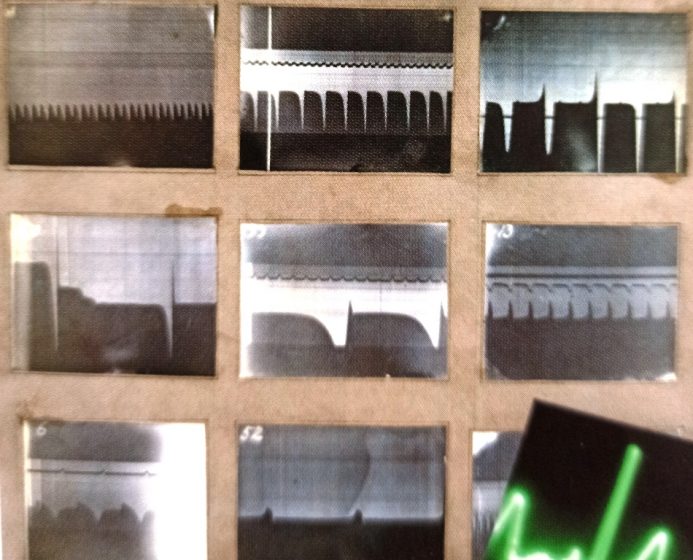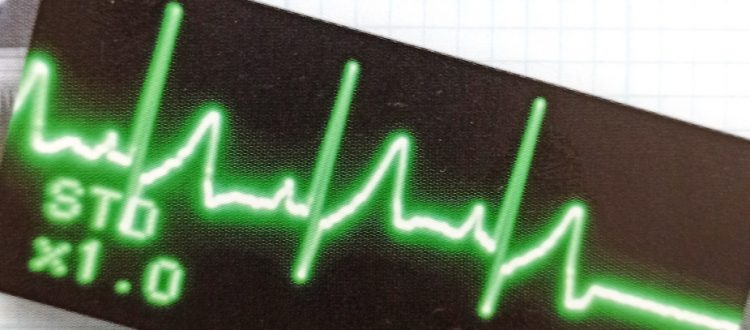The Electrocardiograph 1902
Ever since Luigi Galvani’s pioneering studies in the late 1700s century. Scientists knew that muscle contraction generated weak electrical impulses. The Scottish electrical engineer Alexander Muirhead was the first person to attempt to measure the electrical activity of the heart when in 1872, he attached wires to the wrists of a feverish patient at St Bartholomew’s Hospital in London.
Around the same time, the physiologist John Bordon Sanderson recorded results from a Lippmann capillary electrometer, a device with tubes filled with mercury able to measure small surges of electrical current. Following these experiments, a systematic approach to producing electrocardiograms was made by British neurophysiologist Augustus Waller, who not only placed electrodes on the patient’s skin but also attached the Lippmann capillary electrometer to a projector to produce a trace of the electrical activity.
After trying the method on his dog, Waller applied it to create the first human electrocardiogram (or ECG a term coined later by Dutch physiologist Willem Einthoven to describe the trace left by the heartbeat on a capillary electrometer.
The String Galvanometer
Einthoven recorded the first true electrocardiograph in 1902. To enhance the electrical impulses, he used a galvanometer originally invented by Galvani but perfected by Clement Ader. Einthoven’s string galvanometer incorporated a long, silver-coated quartz filament between two powerful horseshoe-shaped electromagnets.
As the current passed through, the movement in the filament was projected onto a thin photographic plate, indicating the differences in electrical potential generated by the heart’s contractions. Einthoven also worked out exactly where the electrodes should be attached to the skin in order to obtain the most accurate reading. Having identified in 1895, five distinct types of waves emanating from the heart, he devoted the rest of his life to studying and interpreting anomalies in heart rhythm.
Einthoven was awarded the Nobel Prize for physiology and medicine in 1924. The device he invented has become a vital tool in the prevention and monitoring of a wide range of cardiac disease including myocardial infarctions, angina, and heart abnormalities.
His Master Machine
Augustus Waller was demonstrating his capillary electrometer to the Royal Society in London in 1887. To the enormous relief of the assembled luminaries, his dog Jimmy, who had one front and one back paw immersed in a saline solution containing the electrodes, was not electrocuted.

Heartbeat Detector
Photographic plates of heartbeats some from patients undergoing open-heart surgery made by Augustus Waller in the course of his research at St Mary’s Medical School in London.

Lifeline
An ECG trace shows the start of a cardiac arrest, which appears on the screen monitor as an unbroken flat line. Electrocardiograph machines first went into production in 1908.

Precision Waves
Electrocardiographs measure the depolarization (contraction) and repolarisation (relaxation) of the heart’s auricles and ventricles. The first machines required water cooling apparatus for the electromagnets, weight in excess of 270 kilograms. Over time, ECG reading increased in precision as components were miniaturized.
Read About – The History of Sonar – Underwater Listening Device
Product You May be Interested
- Feel Emotional Freedom! Release Stress, Heal Your Heart, Master Your Mind
- 28-Day Keto Challenge
- Get Your Customs Keto Diet Plan
- A fascinating approach to wipe out anxiety disorders and cure them in just weeks, to become Anxiety free, relaxed, and happy.
- Flavor Pairing Ritual Supercharges Women’s Metabolisms
- The best Keto Diet Program
- Boost Your Energy, Immune System, Sexual Function, Strength & Athletic Performance
- Find Luxury & Designer Goods, Handbags & Clothes at or Below Wholesale
- Unlock your Hip Flexors, Gives you More Strength, Better Health, and All-Day Energy.
- Cat Spraying No More – How to Stop Your Cat from Peeing Outside the Litter Box – Permanently.
- Anti-aging nutritional unexplained weight gain, stubborn belly fat, and metabolic slowdown. Reach Your Desired Weight in a Week and Stay There.
- Get All Your Healthy Superfoods In One Drink






